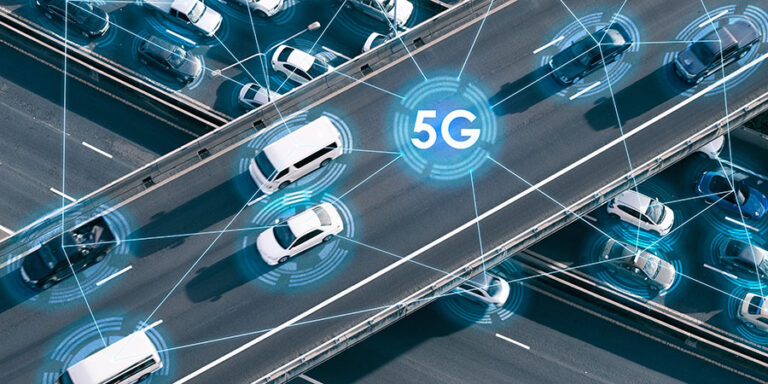In the rapidly evolving landscape of smart transportation, urban centers often dominate the conversation, enjoying cutting-edge infrastructure, connected vehicle technologies, and comprehensive traffic management systems. However, rural America—home to millions of people and critical transportation networks—frequently remains overlooked, suffering from persistent connectivity gaps and outdated traffic infrastructure. These “connectivity deserts” result in reduced safety, diminished mobility, and limited economic opportunities for rural communities.
Kemetra is tackling this disparity head-on, deploying satellite-assisted Vehicle-to-Everything (V2X) communication to bridge connectivity gaps and bring smart roads to even the most remote areas. Our satellite-backed microcell and direct-to-cell communication modules deliver resilient, reliable, and high-speed connectivity, empowering underserved rural communities with next-generation traffic management, enhanced road safety, and increased mobility opportunities.
The Connectivity Crisis in Rural Communities
For many rural areas, lack of reliable connectivity is more than an inconvenience—it’s a safety issue. Poor cellular coverage, limited broadband access, and vast distances between infrastructure points leave rural roadways vulnerable. In emergencies, slow or nonexistent communication significantly delays emergency response, escalating risks and reducing chances of survival.
Moreover, traditional V2X technologies, heavily reliant on ground-based cellular networks, struggle to achieve effective coverage in rural environments. Remote areas are often excluded from the smart mobility advancements transforming urban centers, deepening the digital divide and isolating rural communities from vital transportation innovations.
Satellite-Assisted V2X: Connectivity Anywhere
Kemetra addresses rural connectivity challenges through innovative satellite-assisted V2X solutions, combining satellite technology with advanced cellular microcells to deliver comprehensive coverage regardless of location. Unlike traditional cellular-only methods, our satellite-backed modules eliminate geographic constraints, ensuring continuous, reliable connectivity even in the most remote areas.
With direct-to-cell communication capabilities, our platform bypasses typical infrastructure limitations, instantly providing rural regions with access to cutting-edge intelligent transportation system (ITS) features. This revolutionary approach ensures that critical alerts, safety notifications, and real-time traffic updates reach every road user promptly—no matter how isolated their location.
Enhanced Safety Through Real-Time Communication
One of the most pressing issues facing rural roads is safety. Due to isolation, long distances, and slower emergency response times, rural areas often experience disproportionately high accident rates. Kemetra’s satellite-assisted V2X addresses these concerns by instantly transmitting safety alerts and critical information directly to connected vehicles, mobile devices, and road signs.
For example, our system can automatically detect wildlife crossings, hazardous road conditions, or sudden weather changes in rural regions, immediately notifying drivers miles ahead. Additionally, emergency responders receive precise incident data instantly, significantly cutting response times. This real-time communication dramatically improves safety outcomes, protecting lives across rural America.
Microcell Technology: Bridging the Infrastructure Gap
Kemetra’s innovative microcell technology is instrumental in solving rural connectivity challenges. By deploying compact, satellite-connected microcells along rural roadways, we create robust communication hubs capable of delivering high-speed, low-latency connectivity. This decentralized approach requires minimal infrastructure investment and rapidly expands coverage to remote highways, county roads, and isolated communities.
Our microcells seamlessly integrate with existing roadside infrastructure, further reducing costs and deployment timelines. By enabling effective V2X communication without costly traditional cellular towers, Kemetra ensures that rural communities quickly reap the full benefits of smart mobility.
Economic Opportunities Through Improved Connectivity
Reliable connectivity doesn’t just boost safety—it drives economic development. Rural areas often face economic stagnation partly due to limited transportation infrastructure and lack of dependable connectivity. Kemetra’s satellite-backed solutions empower rural communities by enhancing transportation efficiency, supporting local businesses, and encouraging economic investment.
Connected rural roads enable smarter logistics, efficient agricultural transport, and expanded commerce opportunities. Real-time route optimization reduces delivery times and fuel costs, making rural businesses more competitive. Reliable transportation also attracts businesses and new residents, revitalizing rural economies and fostering community growth.
Seamless Integration with Digital Twin Simulations
Beyond immediate connectivity benefits, Kemetra integrates satellite-assisted V2X into advanced digital twin simulations, helping rural communities proactively manage and plan infrastructure improvements. Digital twin modeling creates virtual replicas of rural road networks, enabling local governments and planners to simulate traffic flows, emergency scenarios, and infrastructure changes accurately.
These simulations allow rural communities to strategically prioritize investments, improve roadway designs, and optimize emergency preparedness. Leveraging predictive insights from digital twin technology ensures rural roads become resilient, adaptable, and prepared for future challenges.
Empowering Rural Agencies with Data-Driven Insights
Kemetra’s solutions provide actionable, data-driven insights tailored to rural communities. Comprehensive analytics on traffic patterns, connectivity quality, incident response times, and infrastructure performance are continuously collected and analyzed. Rural transportation authorities can leverage these insights to enhance roadway safety, improve resource allocation, and justify future infrastructure investments.
By transforming raw connectivity and traffic data into clear, actionable intelligence, Kemetra empowers rural decision-makers, enhancing their capacity to make informed, effective, and community-focused transportation decisions.
Driving Equity Through Inclusive Mobility
Ultimately, Kemetra’s satellite-assisted V2X initiative is fundamentally about equity. By delivering smart road technologies and reliable connectivity to rural America, we bridge the digital divide and ensure all communities—regardless of location—benefit from advances in transportation technology.
Our approach aligns directly with nationwide goals to create equitable mobility solutions, ensuring rural communities receive the same level of safety, connectivity, and infrastructure innovation traditionally reserved for urban centers. With Kemetra, smart mobility becomes an inclusive initiative, reaching every American roadway.
Through satellite-assisted V2X and innovative microcell technology, Kemetra is transforming rural roads into connected, intelligent transportation networks. By ensuring reliable, real-time communication, enhancing road safety, driving economic growth, and promoting equitable mobility, we empower rural communities to thrive in the smart mobility era.



